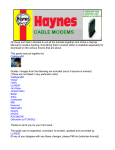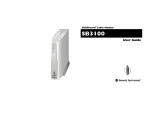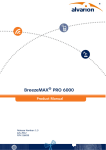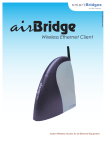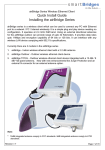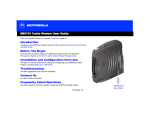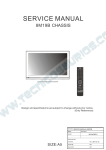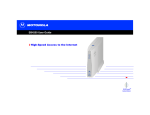Download Motorola SB5101U User guide
Transcript
MOTOROLA SB5101 Cable Modem Overview November 2004 This document, which contains proprietary product information, has been prepared for the express purpose of allowing prospective customers to evaluate the product and service offerings of Motorola. Except as otherwise required by law, it may not be reproduced, used by or disclosed to persons not employed by or retained by Motorola for the evaluation and implementation of this document without the prior written consent of Motorola. SB5101 Cable Modem Overview Version Number 0.0.1 0.0.2 0.0.3 0.0.4 Date 1/11/2004 8/11/2004 Release Status Draft for Comment Added Beachcomber info 1.0.0 1.0.1 1.1.0 1.1.1 MOTOROLA BCS CONFIDENTIAL Page 2 of 34 SB5101 Cable Modem Overview Table of Contents. 1 2 3 Introduction.................................................................................................................. 4 SB5101 Key Features .................................................................................................. 5 SB5101 Benefits for the MSO and End User ............................................................ 6 3.1 3.2 3.3 3.4 3.5 4 Connectivity ................................................................................................................................... 6 Standby Switch.............................................................................................................................. 6 User Guide .................................................................................................................................... 6 Modem Set Up and Diagnostics .................................................................................................... 6 Logistics......................................................................................................................................... 6 SB5101 Architecture. .................................................................................................. 7 4.1 5 6 7 Technical Specifications: ............................................................................................................... 7 DOCSIS - Overview...................................................................................................... 9 SB5101 Indicators and their use for diagnostic purposes. .................................. 10 WEB Page Diagnostic Tool....................................................................................... 11 7.1 7.2 7.3 7.4 7.5 7.6 8 The Status Page .......................................................................................................................... 12 The Signal Page .......................................................................................................................... 13 The Addresses Page ................................................................................................................... 14 The Configuration Page............................................................................................................... 15 The Logs Page. ........................................................................................................................... 16 The Help Page............................................................................................................................. 17 Stormwatch ................................................................................................................ 18 8.1 8.2 8.3 8.4 8.5 8.6 8.7 8.8 Operational Data.......................................................................................................................... 19 The Operational Status Page....................................................................................................... 20 The Operational Statistics Page. ................................................................................................. 21 The Downstream Modulation Characteristics Page ..................................................................... 22 The Downstream Connection Page ............................................................................................. 23 The Upstream Modulation Characteristics Page.......................................................................... 24 The Channel Parameters Page ................................................................................................... 25 The Log Page ............................................................................................................................. 26 9 Modem Profiler - Beachcomber ............................................................................... 27 10 Diagnostic Modem ................................................................................................. 30 10.1 11 Diagnostic Cable Modem Command Line Interface Notes........................................................... 30 Reference Material ................................................................................................. 34 MOTOROLA BCS CONFIDENTIAL Page 3 of 34 SB5101 Cable Modem Overview 1 Introduction The SB5101 Cable Modem is a stand-alone unit with an external power supply, it is the latest product in the Motorola Surfboard range, the SB5101 will be produced alongside the existing SB5100 modem and will eventually replace it. Figure 1: SB5101 Cable Modem The SB5101 offers both Ethernet and USB interface connectivity to ensure compatibility with almost any PC or Macintosh network-ready computer system. The SB5101 Cable Modem received DOCSIS 2.0 certification in Cable Labs Certification wave 28 (April 2004). The SB5101E EuroDOCSIS Cable Modem received the corresponding EuroDOCSIS 2.0 certification in ECW 16 in September 2004. A top panel standby switch has been added for additional end-user security. It disconnects the USB and Ethernet connection to the CPE without disconnecting the cable modem from the RF network; providing a simple but effective reassurance for the customer that their PC is safe from unwanted external access. MOTOROLA BCS CONFIDENTIAL Page 4 of 34 SB5101 Cable Modem Overview 2 SB5101 Key Features ● ● ● ● ● ● ● ● ● ● ● ● ● ● ● ● ● ● ● ● ● ● ● ● ● Optimised to fully utilize 6 MHz DOCSIS Cable Channels DOCSIS 1.1 and 2.0 certified, backwards compatible with DOCSIS 1.0 USB and Ethernet network connectivity allows simple installation. Standby switch enhances security. Up to 100 times faster than a 56k analog phone modem. No telephone lines needed — always on, always connected. Compatible with Windows®, Macintosh® and UNIX® computers. Attractive vertical design saves desk space. Advanced DOCSIS 2.0 hardware platform Supports up to 63 users (1 via USB and up to 62 via Ethernet) Ethernet and USB connections are bridged allowing LAN traffic between USB device and Ethernet LAN Ethernet and USB cables included in the package 10/100BaseT Ethernet (auto sensing) Remote Management via SNMP and Remote Configuration via TFTP Software upgradeable over the network Compact external power supply Platform independent modem with HTML-based user interface for status troubleshooting Front panel LED ’s for easy troubleshooting User guide translates in multiple languages Installation Assistant on CD-ROM gives guidance through the installation process. Global safety approval &certificates: CB scheme (EN60950/IEC950) CE-Evaluation test report (EN55022/EN55024) UL approved Microsoft WHQL approved MOTOROLA BCS CONFIDENTIAL Page 5 of 34 SB5101 Cable Modem Overview 3 SB5101 Benefits for the MSO and End User 3.1 Connectivity The USB port is an important interface for MSOs because it can dramatically reduce their installation time and installation cost. The USB interface was introduced in most PCs starting in 1997. Practically all PCs from 1998 onward were sold with a USB interface. The USB interface allows a user to connect up to 127 devices simultaneously without ever having to open their PC. The MSO saves time by not having to open a PC to install an Ethernet NIC card to install a cable modem. In fact, the USB interface simplifies the cable modem installation so much that in many cases the consumer will be able to self-install the modem, thus making the SB5101 an ideal choice for retail or self installation. In addition to saving time the consumer and MSO will no longer need to invest additional funds for a NIC card. Currently Windows 98, Windows 2000 and Windows XP support the USB interface. A 10/100BaseT Ethernet interface is also available for those customers who do not have a PC with an active USB port or wish to continue to use the Ethernet interface, the connections are bridged so if the MSO allows multiple devices may connect through the Modem simultaneously. 3.2 Standby Switch The SB5101 series also features a standby switch that temporarily disconnects the modem from the PC, thus allowing for a greater degree of security when the user is not surfing while keeping the modem on the network, thus allowing the modem to be monitored, updated, and maintained by the MSO continuously. 3.3 User Guide The SB5101 User Guide is available in multiple languages including German, English, French (including Canadian French), Portuguese (including Brazilian Portuguese), Danish, Swedish, Korean, Japanese, Simplified and Traditional Chinese, Polish, Dutch and Spanish. 3.4 Modem Set Up and Diagnostics The SB5101 has an html based web page that will allow an MSO engineer or a customer to easily troubleshoot any problems with connecting the modem onto the HFC network. In addition there is a Motorola developed program called Stormwatch which allows a dynamic GUI for both local and remote access to an individual Cable Modem. In addition Motorola has developed a Modem Configuration File utility called “Beachcomber” which is designed to simplify the production and maintenance of the essential config files. 3.5 Logistics Motorola has invested in a very sophisticated product fulfilment operation based in Scotland which allows the SB5101 and its accessories to be customised to the needs of individual operators. MOTOROLA BCS CONFIDENTIAL Page 6 of 34 SB5101 Cable Modem Overview 4 SB5101 Architecture. The key physical component portion of the SB5101 system is the BCM3349 chip (Broadcom). The BCM3349 is a single-chip that supports the two advanced communication technologies required by the DOCSIS 2.0 specification – advanced time division multiple access (A-TDMA) and synchronous code division multiple access (S-CDMA). Other parts of the Cable Modem include a BCM3419 Silicon Tuner, SDRAM, non-volatile storage (Flash), Ethernet interface, and USB interface. The SB5101 provides 16 Service ID’s (SIDs) rather than the 4 available with the SB5100, this provides much greater flexibility for the provision of multiple services with individual QoS, determined by the needs of the service, data, voice, video etc. 4.1 Technical Specifications: SB5101 GENERAL Interface to PC Ethernet 10/100-BaseT, RJ-45 connector, USB TCP/IP 15.75cmHx5.52cmW x 15.24cmL Female F-Connector, 75 Ώ Data Protocol Dimensions Cable Interface DOWNSTREAM Modulation Maximum Data Rate Bandwidth Maximum Symbol Rates Operating Level Range Input Impedance Total Input Power Frequency Range 64 or 256 QAM 27 Mbps (in 64QAM mode) or 38 Mbps (in 256QAM mode) (limited by transmission protocol) 6 MHz 5.069 Msym/s (64QAM) 5.361 Msym/s (256QAM) -15 to +15 dBmV 75 ohms (nomimal) < 30 dBmV 88-860 MHz (± 30 kHz min step size) UPSTREAM Upstream Modulation Maximum Upstream Rate Bandwidth MOTOROLA BCS 16QAM or QPSK, (8, 32, 64 and 128 QAM with A-TDMA or S-CDMA enabled CMTS) Transmission 10 Mbps (30Mbps with A-TDMA or SCDMA enabled CMTS) 200, 400, 800, 1.6 MHz, 3.2 MHz; CONFIDENTIAL Page 7 of 34 SB5101 Cable Modem Overview SB5101 Symbol Rates Operating Level Range Output Impedance Total Input Power Frequency Range 6.4MHz with A-TDMA or S-CDMA enabled CMTS 160, 320, 640, 1280, and 2560 ksym/s, 5120 ksyms/s with A-TDMA or S-CDMA enabled CMTS +8 to +55 dBmV (8, 16QAM) +8 to +58 dBmV (QPSK) +8 to +54 dBmV (32, 64 QAM) +8 to +53 dBmV (S-CDMA) 75 ohms (nominal) < 35 dBmV (varies by symbol rate) 5-42 MHz (edge to edge) ENVIRONMENTAL Power Input Power 9 Watts (nominal) 100-240 VAC 50-60 Hz Operating Temperature Storage Temperature Operating Humidity 0 to +40 °C -30 to +80 °C 0-95% RH, non-condensing MOTOROLA BCS CONFIDENTIAL Page 8 of 34 SB5101 Cable Modem Overview 5 DOCSIS - Overview The DOCSIS system was developed to enable hardware and systems interoperability and automated configuration and management. Cable Modems (CM’s) and Cable Modem Termination Systems (CMTS’s) from various vendors will operate on the same network, using the common DOCSIS standards and protocols. In this model, a CM is authorized by the CMTS for use on the network, and configures itself according to parameters that are passed to it from the head-end. This sequence of events will occur automatically in the background, so the user will be unaware of the activity. The following paragraph describes the process of how a CM “logs on” to the network. When the CM is powered on, it follows one of two scenarios. If it is logging on to the network for the first time (or the data frequency has been changed), the CM automatically scans the frequency spectrum to locate the data frequency. If the CM has previously accessed the network, it will lock onto the data frequency automatically (the previous session value is stored). Once the CM finds the DOCSIS data signal, it looks for a message that contains the basic parameters for the upstream (frequency, modulation, symbol rate, FEC format, etc.). The CM can then transmit a message to the CMTS requesting additional information that will enable it to connect to the network. Through a series of messages and interactions, the CM will establish IP connectivity using DHCP, (dynamic addressing), and then will receive a configuration file via TFTP that has additional parameters the CM needs to configure itself. Once the CM has been configured, it will register with the CMTS and be authorized for use of the network. If Baseline Privacy has been enabled, the final step of the initialization is establishing the parameters to use Baseline Privacy. Once the CM has been configured and authorized, it can use the network like any standard Ethernet network device. The Operations Support System (OSS) software in the CMTS communicates with all the CMs and has the ability to re-configure them to use different channels, to change their parameters, and to disable their ability to use the network. MOTOROLA BCS CONFIDENTIAL Scan for Downstream Channel Obtain Upstream Parameters Perform Ranging & Automatic Adjustments Establish IP Connectivity Sync to Network Clock Transfer Operational Parameters Register with CMTS Establish Baseline Privacy Page 9 of 34 SB5101 Cable Modem Overview 6 SB5101 Indicators and their use for diagnostic purposes. The indicators on the surfboard modem are designed to be helpful to both the end user and the network operator. The indicators allow an initial diagnosis to be made as to the likely cause of reported problem. The problems which can be diagnosed divide into the modem itself, the power light does not go solid green; the HFC network, either the Receive or Send does not go solid green; the IP network, the Online does not go solid green or finally the user CPE, no activity light. LED/ Label Power Receive Send Online PC Activity Standby MOTOROLA BCS Description (Indication) OFF/Startup (post test)/ ON Scanning for RF/ Locked to Downstream RF Ranging with CMTS/ Acquired upstream RF Acquiring IP connectivity/ Operational Indicates traffic seen by CM Indicates state of Standby Option CONFIDENTIAL Page 10 of 34 SB5101 Cable Modem Overview 7 WEB Page Diagnostic Tool. The Cable Modem has three active interfaces, the HFC, the Ethernet and the USB and each interface has both a MAC and an IP address associated with it. When operating normally it is the IP address of the HFC interface that is used for diagnostic access to the modem. However the IP address associated with the Ethernet interface is always available to the client side network, unless it has been disabled by management command. This means that a PC on the client side can access the WEB pages within the modem using the reserved address 192.168.100.1. This is a non-routed address so it cannot be reached from the Internet (routed) side of the network The SB5100 family of modems contain an internal DHCP server, which is active until the modem registers with the CMTS. In the case of a problem that prevents the modem from completing its registration, the modem can still give an IP address to the client PC to enable diagnostics access. This address is given with a very short lease (around 10 seconds) so that as soon as the registration does complete the client PC obtains its proper IP address from the core network DHCP server. The WEB interface consists of the following pages: MOTOROLA BCS CONFIDENTIAL Page 11 of 34 SB5101 Cable Modem Overview 7.1 The Status Page This Page shows the main steps in the registration process, in this case a successful registration a failed step would be marked in red. The “skipped” entry for baseline privacy is because this facility has not been activated via the configuration file. MOTOROLA BCS CONFIDENTIAL Page 12 of 34 SB5101 Cable Modem Overview 7.2 The Signal Page This page shows the downstream and upstream RF signal characteristics, in this case for an operational modem. One important feature of this page is that shows the signal to noise ratio on the down stream and the power level on the upstream, both good indicators of the condition of the HFC network link. MOTOROLA BCS CONFIDENTIAL Page 13 of 34 SB5101 Cable Modem Overview 7.3 The Addresses Page This page is concerned with the link level and network level addressing in use by the modem. It serves to confirm that the correct DHCP information is being used and it also identifies the client CPE in use, in this case limited to one device. MOTOROLA BCS CONFIDENTIAL Page 14 of 34 SB5101 Cable Modem Overview 7.4 The Configuration Page This page allows the option (if made available) of configuring locally some of the parameters that govern the behaviour of the modem. One possibility is to disable the built in DHCP server perhaps because a client is already using the same address band. MOTOROLA BCS CONFIDENTIAL Page 15 of 34 SB5101 Cable Modem Overview 7.5 The Logs Page. This page can be very useful as it shows what has happened to the modem since power on. The log space is used in a cyclic manner and the most recent entry is at the top. In this case the modem has gone into normal operating mode and the timestamps start when the modem has contacted the time of day server. MOTOROLA BCS CONFIDENTIAL Page 16 of 34 SB5101 Cable Modem Overview 7.6 The Help Page This final page serves to explain the function of the previous pages as well as containing information on the software versions in use. MOTOROLA BCS CONFIDENTIAL Page 17 of 34 SB5101 Cable Modem Overview 8 Stormwatch Stormwatch is a diagnostic tool to monitor and troubleshoot Cable Modems from the CPE or HeadEnd. Stormwatch provides a real-time visual status of SURFboard Cable Modems it also provides the status of the standard SNMP objects on any DOCSIS Modem Stormwatch monitors Cable Modem via SNMP objects Stormwatch can be CPE or Head-end based The Stormwatch application allows for one time load, or a permanent installation. It is also available in two versions one of which is read only and the other is read write. In the read only version the drop down tags which allow options to be changed do not appear hence there is no way to modify modem parameters. MOTOROLA BCS CONFIDENTIAL Page 18 of 34 SB5101 Cable Modem Overview 8.1 Operational Data This page shows general information about the modem, in particular what version of software is in use. MOTOROLA BCS CONFIDENTIAL Page 19 of 34 SB5101 Cable Modem Overview 8.2 The Operational Status Page. This page shows the operational status of the modem, in this case fully operational. As this is a dynamic page variations in signal to noise or power levels can be viewed in (almost) real time. In this case the screen shows that the modem has loaded a configuration file called generic.cm again this is useful confirmation that the required file is actually in use. MOTOROLA BCS CONFIDENTIAL Page 20 of 34 SB5101 Cable Modem Overview 8.3 The Operational Statistics Page. The main feature of this page is to confirm how long the modem has been operating MOTOROLA BCS CONFIDENTIAL Page 21 of 34 SB5101 Cable Modem Overview 8.4 The Downstream Modulation Characteristics Page This page shows the physical characteristics of the downstream link and in particular the signal to noise ration and whether any FEC errors have been detected. MOTOROLA BCS CONFIDENTIAL Page 22 of 34 SB5101 Cable Modem Overview 8.5 The Downstream Connection Page This page displays IP specific information about the downstream connection it shows which client CPE addresses have been learned and also any packet errors that have occurred. MOTOROLA BCS CONFIDENTIAL Page 23 of 34 SB5101 Cable Modem Overview 8.6 The Upstream Modulation Characteristics Page. This page contains important physical information about the performance of the upstream link. In particular it shows the Power Level and whether or not the modem has retuned, both good indicators of link integrity. MOTOROLA BCS CONFIDENTIAL Page 24 of 34 SB5101 Cable Modem Overview 8.7 The Channel Parameters Page This page allows certain parameters to be set on the modem if that facility has been allowed. One possibility may be to lock the modem to different frequency plan when moving between networks for diagnostic purposes. MOTOROLA BCS CONFIDENTIAL Page 25 of 34 SB5101 Cable Modem Overview 8.8 The Log Page This page is dynamic and new logs are added at the bottom of the screen in the style of a standard scrolling window. This log shows the final stages of a successful connection sequence. In addition to the screens themselves there is also the option of using drop down menus to set particular parameters should than facility have been enabled. MOTOROLA BCS CONFIDENTIAL Page 26 of 34 SB5101 Cable Modem Overview 9 Modem Profiler - Beachcomber Beachcomber is a DOCSIS 1.0/1/1/2.0 Cable Modem Configuration file editor which runs on Windows, Linux and Unix based systems. It features a simple Java based user interface which includes checking of data fields as they are entered. It is a tool designed to make life easier for both the experienced operator by automating the configuration process and for the less experienced operator by providing extensive help facilities. MOTOROLA BCS CONFIDENTIAL Page 27 of 34 SB5101 Cable Modem Overview One aspect of configuration management which needs to be managed carefully is the use of Filters and Access lists. These tables are used by the operator to determine what services their customers and use and more importantly to block activities which the operator does not want to allow. MOTOROLA BCS CONFIDENTIAL Page 28 of 34 SB5101 Cable Modem Overview DOCSIS 1.1 introduced the idea of Service Flows with individual QoS levels so that an operator can distinguish between the QoS requirements of different types of end user service and allocate the resources required to ensure the customer actually receives the service they are paying for. Beachcomber allows the definition of both the upstream and downstream service flows and the classifiers which determine the admission to those flows, the graphical presentation makes it easy to see what is being configured and to compare the details of different configurations. MOTOROLA BCS CONFIDENTIAL Page 29 of 34 SB5101 Cable Modem Overview 10 Diagnostic Modem The diagnostic modem is physically the same as a customer modem except that it is orange in colour, it has a small jack socket on the rear and it has a special “shelled” version of the microcode. This is a simplified Korn shell system, which allows the user to log onto the device and set diagnostic switches to trace and log what is happening on the network. This is a very powerful tool for tracing intermittent and otherwise difficult faults. 10.1 Diagnostic Cable Modem Command Line Interface Notes The CLI can only be accessed via an “rlogin” based Telnet client or the Diagnostic Console Cable and the DIAG port on the back of the modem. Modems that are going to be used as Diagnostic Tools and use the CLI must have the “SHELL” version of modem firmware. MOTOROLA BCS CONFIDENTIAL Page 30 of 34 SB5101 Cable Modem Overview 10.1.1 Connecting to the Cable Modem via Diagnostic Console Cable: The CLI can be accessed via the Diagnostic Console Cable and the DIAG port on the back of the modem. This is typically done via “Windows HyperTerminal” with the following settings: • • • • • Bits per second: Data bits: Parity: Stop bits: Flow Control: 38400 8 None 1 None Diagnostic cables are supplied with the modems. 10.1.2 Connecting to the Cable Modem via Ethernet and an “rlogin” based Telnet Client: Modem Ethernet IP address: To access CLI from HFC side: To access CLI from client CPE: 192.168.100.1 rlogin <modem IP address from DHCP> rlogin 192.168.100.1 10.1.3 Logging Into the Cable Modem: Login name: Password: target first 15 digits of the unit serial number (It is best to copy these into a Notepad Window first, then copy/paste to the Terminal Window you are using for access.) 10.1.4 Key Commands: Addressing Displays modem addressing information (Ethernet MAC and IP) arpstorm Displays ARP Storm filter statistics blpinfo Displays Baseline Privacy Key Management information bootChange Changes modem boot parameters bridge Displays state of bridge forwarding layer and statistics clrcpemac <xx-xx-xx-xx-xx> Clear one static CPE MAC address from Table of known CPE’s. Number of CPE’s (Controlled by TFTP TLV Value MaxCPE) config Use to set modem configuration settings, such as starting frequency ranges, known frequency and other registration/scanning parameters cpemac Lists MAC addresses known by the modem including those provisioned and learned. defaultcfg Sets the modem back to factory defaults dhcpc Displays modem DHCP configuration information received from server dlfile Downloads new software image from a specified server through TFTP dsdiag Displays downstream diagnostic information, (frequency, SNR, FEC lock status) eventlog Displays event logs up to 173 entries, with wraparound buffer exit | quit Exit the login session factSetCliOff Turns off CLI after next reboot help | ? Lists available CLI commands haltreset Cancels reset action request MOTOROLA BCS CONFIDENTIAL Page 31 of 34 SB5101 Cable Modem Overview Displays VxWorks host name table Displays a summary of each task and associated TCB (Task Control Block) Display information about all attached network interfaces Displays information about specific interface Displays IP filter cache information Displays IP filter cache statistics Displays state of IP filters Displays Engineering symbols whose values are near a specified value Displays LLC filter information Displays MAC packet counts and statistics Displays system memory partition blocks and statistics Displays multicast protocol information Displays statistics for all protocols Displays statistics for ICMP Displays IP statistics Displays all active connections for IP sockets Displays routing tables Displays statistics for the TCP protocol Displays statistics for the UDP protocol Ping an IP address Ping an IP host by name (names are only configurable at the Engineering Diagnostic Level) quit Exits the login session reset Reset the Cable Modem rlogin <hostname> Establishes a rlogin session to hostname (names are only configurable at the Engineering Diagnostic Level) routes Displays host and network routing table setdbg Sets some debug flags (see below) startuplog Displays startup log information telnet <x.x.x.x> Establishes a telnet session tftpinfo Displays TFTP information usdiag Displays upstream diagnostic information, (SID, power level, frequency, rate) ver Displays software/hardware versions hosts I ifconfig ifconfig [interface] ipcache ifcachestat ipfilter lkAddr [addr] llcfilter macstat memShow multicast netstat netstat –icmp netstat –ip netstat –inet netstat –rn netstat –tcp netstat –udp ping <x.x.x.x> ping <hostname> 10.1.5 Key Debug Flags: <Set through CLI setdbg command> <By default, they are set to 0, except QAM 16 Preamble is set to 1> Ignore Auto Update IF 1, Do not auto update the Firmware image upon registration IF 0, Auto update the Firmware image as designated by TFTP Config file Canned Registration IF 1, DHCP, TOD, TFTP will be bypassed and canned registration will be used Fine Scan on IF 1, Do fine scan Use Scan Limit IF 1, Perform scan within parameters of the defined scan limits DHCP Debug On IF 1, DHCP Debug statements are displayed Confg Debug On IF 1, Config Debug statements are displayed TOD Debug On IF 1, Time of Day Debug statements are displayed MOTOROLA BCS CONFIDENTIAL Page 32 of 34 SB5101 Cable Modem Overview Reg Debug On Scan Debug On MMT Cmd Debug On Range Debug On UCD Debug On UU Debug On CLI Off BLP Off QAM16 Preamble Frequency step size Scan lower limit Scan upper limit MOTOROLA BCS IF 1, Registration Req/Res values are displayed IF 1, Then each frequency tested will be printed scan IF 1, MMT Debug statements are displayed IF 1, Ranging Debug statements are displayed IF 1, UCD Debug statements are displayed IF 1, Unit Update debug statements are displayed IF 1, Turns off CLI shell. Use vxWorks Operating System Shell IF 1, Turns off Baseline Privacy. IF 1, use QAM 16. IF 0, use QPSK Set to Values (50000 - 8000000 Mhz): [default = 6000000] Set lower Scan Limit Starting Point (0 - 800 MHz) Set lower Scan Limit Starting Point (0 - 900 MHz) CONFIDENTIAL Page 33 of 34 SB5101 Cable Modem Overview 11 Reference Material Motorola has shipped over 20 million modems since 1996 and has monitored the actual in service failure rate over that time. The results are summarised below: • • • • • SB2100 – After 12 months and more than 93k units shipped, the SB2100 has an AFFR of <.97%, and an actual MTBF of 95 years SB3100 – After 24 months and more than 1.6M units shipped, the SB3100 has an AFFR of <.5%, and an actual MTBF of 225 years SB4100 – After 20 months and more than 3.4M units shipped, the SB4100 product has an AFFR of <.19%, and an actual MTBF of 514 years SB4200 – After 12 months and more than 4M units shipped, the SB4200 product had an AFFR of <.08%, and an actual MTBF of 525 years SB5100 – After 6 months and more than 3M units shipped, the SB5100 product has an AFFR of <.005%, and an actual MTBF of over 525 years MOTOROLA BCS CONFIDENTIAL Page 34 of 34


































